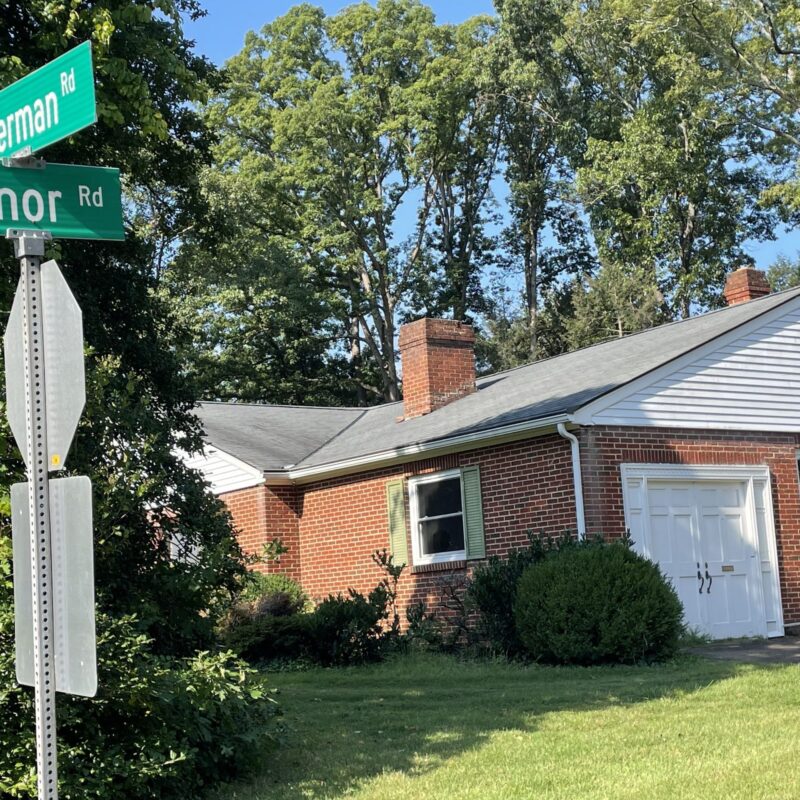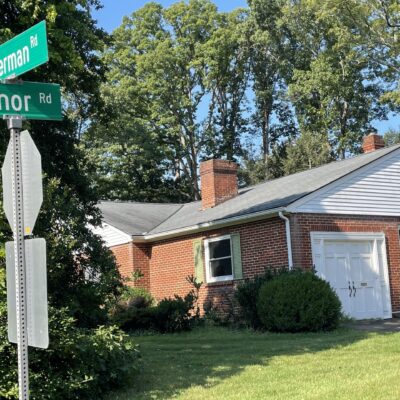Willie Drake makes the most out of being a mountain man
Willie Drake, founder of world-renowned Mountain Lumber Co., a reclaimed wood and millwork company in Ruckersville with a showroom in the Main Street Market, says he fell in love with salvaging abandoned wood timbers from old barns and factories “long before I was an environmentalist.”
|
Willie Drake sits on his own floor made of English Brown Oak reclaimed from cider vats in England. He alternated cider-stained slats from inside the barrel with unstained slats from outside to create the pattern. |
When he started his business over 35 years ago, he says, “I wanted to see how beautiful they could be, but I wasn’t going out to save the world.”
Though he wasn’t thinking on a global scale at the time, he was motivated by a desire to combat the loss of such valuable resources to the landfill (a common practice then as now). Drake observed that Civil War-era mills and factories were being demolished with near-impunity.
“I was just in awe of these big beautiful timbers being trashed by the bulldozers.”
Drake first ventured into procuring antique wood for reuse because of a carpentry job. A builder had asked him to reclaim American chestnut from dilapidated Appalachian barns in West Virginia. A Charlottesville native, Drake had recently dropped out of UVA shortly after returning from the Vietnam War to help out a carpenter friend and spend more time rafting and hiking in the mountains of West Virginia—his true passion.
“I didn’t know what I was doing,” says Drake of that first project. In the early years, he had to rely on his skills as an outdoorsman and his love of the backwoods to get going in the reclaiming business. Mostly that meant sourcing in rural West Virginia and in the Northeast, where projects that involved the destruction of early American factories, such as Camden Yards in Baltimore, were leaving a large wake of abandoned wood.
Back then, though, no one else knew what they were doing, either. In the mid 1970s, Drake recalls there were maybe two or three other companies in the country reclaiming antique wood and milling it for new flooring. At that time, there also were fewer regulations governing the demolition of historic mills and factories, making it a virtual free-for-all. Drake now estimates that there are over 500 companies in the U.S. offering reclaimed wood flooring and related products. Many of them, however, rely on brokers to find and source the stuff.
“It’s become much harder to procure and almost like a commodity,” says Drake.
At MLC, by contrast, Drake himself still does most of the purchasing of old wood from around the world that is transformed by MLC’s staff of millworkers and craftsman into an array of flooring products. Those range from solid “Antique American Oak” to centuries-old “Antique Chinese Elm.” Less a commodity than a piece of history, much of MLC’s wood tells a tale of its unique past in all the distress marks and worm holes it shows; although, the company also sells “smooth” lines of reclaimed products where all signs of natural and man-made patina have been milled and buffed away—if that’s your preferred look.
Though MLC has a long list of residential and commercial customers (including the likes of Monticello, the National Cathedral Chapel and the Portland Museum of Art), Drake says most clients today, who pay a much higher price for reclaimed than newly sawn wood, seem motivated by the overall look of the wood and MLC’s reputation for quality rather than by a deep concern for recycling. That’s O.K., though; we know and now you know that Drake’s doing his part to save the world from becoming one big trash heap.
The clothes off your back: Call her Secondhand Rose
Rosalba Valentino grew up off the grid on an Appalachian farm where her parents farmed, gardened and experimented with hydropower. “I grew up being more concerned with what we’re consuming in resources,” says the clothes designer, who specializes in transforming vintage garments and accessories. Though she also works as a custom designer for weddings, theater and other special occasions and can sew whatever fabrics her clients demand, her true passion is in making original pieces from unique old finds, such as vintage beading and dated clothes with bad designs but great prints. She sources from local vintage stores and antique shops such as Glad Rags, Antics, Goodwill and the Covesville Store and sells most of her original pieces at crafts festivals, farmer’s markets and through her online Etsy store (www.rosalba.etsy.com).
|
Rosalba Valentino and one of her “secondhand” designs. |
“The word ‘secondhand’ has such a negative connotation, but I think old things are totally unique,” says Valentino, who’s inspired by wondering about the previous lives of her found treasures.
She first learned to sew as a kid and later studied at Virginia Commonwealth University in Richmond, majoring in Craft/Material Studies. She also worked with several different materials from ceramics to metals before settling on fibers and fabric for her professional career.
“I’d say I’m more of an artist than a fashion designer. I just happen to work with clothes as my medium,” she says.
The downside to making one-of-a-kind pieces, however, is that Valentino doesn’t have a lot of stock (or, in most cases, more than one size) of any one thing to market, and though she hopes one day to offer at least more size options, she relies on customers who appreciate wearing something unique.
As for future projects, she’d love to convince some of her bridal clients to take advantage of her stack of vintage lace, but “brides want to be new and shiny” and often are unwilling to “let go of a sense of perfection.”
Valentino herself, of course, is willing to throw caution to the wind with her own wedding planned for next year. She found her dress at Glad Rags.
Bill Hess: a glass act
Bill Hess probably is the most overeducated glass artist on the planet. He has a Bachelor of Arts from Dartmouth College with a double major in engineering sciences and studio art and a Bachelor of Engineering. There’s also a Master of Science in Biomedical Engineering from Northwestern University. All of that study came in handy while he was a mechanical engineer for a big product development firm in Chicago and later as he was designing prosthetics for a healthcare corporation. But while he was making plastic-based snowboard bindings and deodorant dispensers, he says he started to worry that “all of this is going right into the landfill.”
|
Hess transforms old glass bottles into new works of art and design. |
“I moved to Seattle and all these ideas about social responsibility started bubbling up and converging with ideas for design. I started thinking more about recycling.”
It was around this time in 1998 that he came to give his own artistry and design ideas legs. He formed a design business called, natch, Ideas on Legs (www.ideasonlegs.com), and enrolled in classes at Seattle’s Pratt Fine Arts Center to further develop his aesthetic skills.
“I wanted to infuse more light and color into my metal work,” says Hess.
At Pratt he discovered a passion for glass. In the Northwest, however, where glass artistry is prevalent and everyone knows of Dale Chihuly, the medium is all about precision and perfection. One bubble or crack and a typical glass artist will scrap the whole thing. With recycled glass, imperfections and irregularities are the norm. They’re what give recycled glass pieces their character. As Hess puts it on his website: “…even cracked or broken glass creations, while having a seemingly failed sense to them, often display an unexpected kind of magic.”
Hess now operates his glass and metal studio out of his Afton home where he sees himself as a modern day alchemist. He combs junkyards and recycling centers for most of his glass. He then melts and reshapes the glass in a kiln and designs and molds kitchen and bathroom tiles, countertops, vanity sinks, lamps, sconces, bird baths and window blocking, as well as fine art pieces and jewelry. Much of his work incorporates salvaged metalwork as well.
Hess’ vision is to establish a manufacturing facility near his home studio where he can produce more recycled glass products for home interiors, but doesn’t suspect he’ll ever be at a loss for sourcing the glass itself as markets for the material are not robust.
But when glass isn’t recycled back into bottles or useful products like Hess’, its true value is being lost. “It takes too much energy to get it back out of the earth,” says Hess. “You have to start from scratch again.”
Lucia Phinney hears the call of the wild
“I’ve always been concerned with the future of humanity and this little piece of land called the earth and how that interacts with architecture,” says Lucia Phinney, an architect, landscape architect and lecturer at UVA’s Architecture School. Phinney’s latest experiments and interests are in designing rainwater collection ponds and reflective shade-cloth covered trellis systems that together create cool, moist microclimates between and around structures. Her online faculty profile describes her work as exploring “the means to reveal rather than erase the incredible potential for natural systems to effectively engage and inform the places we make.” The North Garden home she shares with partner and fellow architect Robin Dripps is informed by frogs. Many frogs.
|
Bioremediation canal and south porch at Phinney-Dripps home. |
“I know all the calls. Wood frogs. Spring Peepers. Carpenter frogs. This is the perfect habitat for them,” says Phinney.
That frog-friendly haven comes from Phinney and Dripps having designed ways to control the flows of wind, water and light around their 3,000-square-foot home by a system of lattice and scaffolding covered in agricultural screen fabrics, reflective shade cloths and acrylic panels. In addition to that rigging, rainwater is collected on the roof and directed into cannons that deposit the water into a canal that varies in depth from two feet to six inches where jetted pumps spray the water back up into the air. The water and adjacent covered trellis system work together, using the energy from the air, to create evaporative cooling and thereby a comfortable ambient outdoor environment for frogs and people (and mosquito-eating fish) in the warmer months. The reflective shade cloths and screens also buffer the inside of the home from extreme temperatures from both sunlight and harsh winds.
Architecturally, what they’re doing is creating “fluidity where outside becomes part of the living experience,” says Dripps. Environmentally speaking, what they’re doing, in a sense, is recycling the weather and using it to keep their own energy consumption down. Phinney says that they didn’t turn on their air conditioner once this past summer and instead spent the season with their glass doors sprung wide open to the light and breeze filtered by the screens and shade cloth and cooled by the water vapor.
The wider implications of this work are vast and global: Just think how different life in the suburbs or in office buildings would be if we didn’t have to spend so much of the year cooped up by our air conditioners or heaters, but could regulate and enjoy the open air by harnessing the weather’s own elements.









